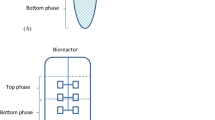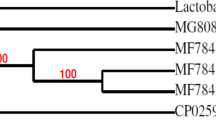Abstract
Lactococcus lactis spp. lactis and Lactococcus lactis spp. cremoris are widely used in the manufacture of fermented milk. These strains were compared for production of Dipeptidyl Peptidase IV (DPP IV) enzyme in terms of enzyme activity, specific growth rates and productivity. Lactococcus lactis spp. lactis was produced in 3 L bioreactor and scaled up to 30 and 150 L stirred tank bioreactors, and the enzyme activities were found as 110, 110 and 122 mU mL−1, respectively. After 8 h of production, separation steps were performed. While purification fold was 127 and yield was 2.69 %, the molecular weight of the enzyme was estimated as 68 kDa. Partially purified enzyme was enteric coated with capsules and a 95.5 % of DPP IV enzyme passed into the artificial intestine. Results show that production of DPP IV enzyme by Lactococcus lactis spp. lactis strain in submerged culture is comparable with the productions by commercial strains, mostly Aspergillus, in solid state fermentations based on productivity.









Similar content being viewed by others
Abbreviations
- CNS:
-
Central nervous system
- CSL:
-
Corn steep liquor
- CSLM:
-
Corn steep liquor mixture
- DPP IV:
-
Dipeptidyl peptidase IV
- D i :
-
Diameter of impeller
- μ:
-
Dynamic viscosity
- ε:
-
Energy dissipation
- HPMCP:
-
Hydroxypropyl methylcellulose phthalate
- h:
-
Hour
- L:
-
Liter
- mL:
-
Milliliter
- mU:
-
Milliunit
- MW:
-
Molecular weight
- n :
-
The rotational speed of impeller
- N P :
-
Power number
- OD:
-
Optical density
- P/V :
-
Volumetric power input
- P :
-
Stirring power
- Re i :
-
Reynolds number
- R f :
-
Retention factor
- ν:
-
Impeller-tip speed
- υ:
-
Kinematic viscosity
- ρ:
-
Liquid density
- τ:
-
Shear stress
References
Reichelt KL, Knivsberg AM, Nodland M (1994) Nature and consequences of hyperpetiduria and bovine casomorphins found in autistic syndromes. Dev Brain Dysfunct 7:71–85
Hegen M, Kameoka J, Dong RP, Schlossman SF, Morimoto C (1997) Cross-linking of CD26 by antibody induces tyrosine phosphorylation and activation of mitogen-activated protein kinase. J Immunol 90:257–264
Cunningham DF, Connor BO (1997) Proline specific peptidases. BBA Protein Struct M 1343:160–186
Aertgeerts K, Ye S, Tennant MG, Kraus ML, Rogers J, Sang BC, Skene RJ, Webb DR, Prasad GS (2004) Crystal structure of human dipeptidyl peptidase IV in complex with a decapeptide reveals details on substrate specificity and tetrahedral intermediate formation. Protein Sci 13:412–421
Reichelt KL, Hole K, Hamberger A, Saelid G, Edminson PD, Braestrup CB, Lingjaerde O, Ledaal P, Orbeck H (1981) Biologically active peptide-containing fractions in schizophreina and childhood autism. Adv Biochem Psycopharmacol 28:627–643
Shattock P, Kennedy A, Rowell F, Berney T (1990) Role of neuropeptides in autism and their relationship with classical neurotransmitters. Brain Dysfunct 3:328–345
Brudnak MA (2001) Genomic multi-level nutrient-sensing pathways. Med Hypotheses 56:194–199
Brudnak MA, Rimland B, Kerry RE, Dailey M, Taylor R, Stayton B, Waickman F, Waickman M, Pangborn J, Buchholz I (2002) Enzyme-based therapy for autism spectrum disorders—is it worth another look? Med Hypotheses 58:422–428
Langford WS (2003) A Comprehensive guide to managing autism. Vries K (ed slightly changed). Drunen, Holland
Reichelt KL, Knivsberg AM (2003) Can the pathophysiology of autism be explained by the nature of the discovered urine peptides? Nutr Neurosci 6:19–28
Lambeir AM, Proost P, Scharpé S, De Meester I (2002) A kinetic study of glucagon-like peptide-1 and glucagon-like peptide-2 truncation by dipeptidyl peptidase IV, in vitro. Biochem Pharmacol 64:1753–1756
Urade M, Uematsu T, Mima T, Tamai S, Ho K, Kato H (1992) Serum DPP IV activity in hamster buccal pouch carcinogenesis with 9, 10-dimethyl- 1, 2-benzanthracene. J Oral Pathol Med 21:109–112
Iwaki-Egawa S, Watanabe Y, Kikuya Y, Fujimoto Y (1998) DPP IV from human serum: purification, characterization, and N-terminal amino acid sequence. J Biochem 124:428–433
Wilkinson RE, Houston DB (2001) Compositions containing dipeptidyl peptidase IV and tyrosinase or phenylalaninase for reducing opioid-related symptons. US Patent 6,251,391. http://www.patentstorm.us. Accessed 30 Dec 2008
Ota T, Itoh A, Tachi H, Kudoh K, Watanabe T, Yamamoto Y, Tadokoro T, Maekawa A (2005) Synthesis of morphiceptin (Tyr-Pro-Phe-Pro-NH2) by dipeptidyl aminopeptidase IV derived from Aspergillus oryzae. J Agric Food Chem 53:6112–6116
Lloyd RJ, Pritchard GG (1991) Characterization of x-prolyl dipeptidyl aminopeptidase from Lactococcus lactis subsp. lactis. J Gen Microbiol 137:49–55
Smid EJ, Poolman B, Konings WN (1991) Casein utilization by lactococci. Appl Environ Microbiol 57:2447–2452
Perez-Guzman AE, Victoria TC, Cruz-Camarillo R, Hernandez-Sanchez H (2004) Improvement of fermentation conditions for the production of x-prolyl-dipeptidyl aminopeptidase from Lactococcus lactis. World J Microbiol Biotechnol 20:413–417
Hamdi M, Hamza S, Mtimet N, Hmida N, Cornelius C, Zgouli S, Mahjoub A, Thonart PH (2000) Effect of corn steep liquor supplementation and scale up on Lactococcus starter production. Bioprocess Eng 22:23–27
Aiba S, Humphrey AE, Millis NF (1973) Biochemical engineering (2nd edn). Academic press, New York
Bailey JE, Ollis DF (1986) Biochemical engineering fundamentals (2nd edn). Mc Graw Hill, New York
Hempel DC, Dziallas H (1999) In: Flickinger MC, Drew S (eds) Encyclopedia of bioprocess technology. University of Minnesota, New Jersey, p 2316
Tramper J, Vlak JM, Gooijer CD (1996) Scale up aspects of sparged insect-cell bioreactors. Cytotechnology 20:221–229
Liggett RW, Koffler H (1948) Corn steep liquor in microbiology. Bacteriol Rev 12:297–311
Hull SR, Yang BY, Venzke D, Kulhavy K, Montgomery R (1996) Composition of corn step water during steeping. J Agric Food Chem 44:1857–1863
Smid EJ, Driessen AJM, Konings WN (1989) Mechanism and energetics of dipeptide transport in membrane vesicles of Lactococcus lactis. J Bacteriol 171:292–298
Neviani E, Boquien CY, Monnet V, Phan Thanh L, Gripon JC (1989) Purification and characterization of an aminopeptidase from Lactococcus lactis subsp. cremoris AM2. Appl Environ Microb 55:2308–2314
Senjkovic R, Becirevic M, Rudic J (1990) Pharmaceutical availability of papaverine hydrochloride from spray-dried products prepared with cellulose phthalates. Pharmazie 45:749–751
Kirilmaz L (1993) Two new suggestions for pharmaceutical dosage forms: ethylcellulose and cellulose acetate phthalate capsules. Stp Pharma Sci 3:374–378
Sigma (2006) In: Quality control procedure, Quality control procedure enzymatic assay of dipeptidyl peptidase IV (EC 3.4.14.5). Germany, pp 1–2
Bradford MM (1976) A rapid and sensitive method for the quantitation of microgram quantities of protein utilizing the principle of protein-dye binding. Anal Biochem 72:248–254
Laemmli UK (1970) Cleavage of structural proteins during the assembly of the head of bacteriophage T4. Nature 227:680–685
Tan PST, Chapot-Chartier MP, Pos KM, Rousseau M, Boquien CY, Gripon JC, Konings WN (1992) Localisation of peptidases in lactococci. Appl Environ Microbiol 58:285–290
Zevaco C, Monnet V, Gripon JC (1990) Intracellular x-prolyl dipeptidyl peptidase from Lactococcus lactis spp. lactis: purification and properties. J Appl Bacteriol 68:357–366
Terzaghi BE, Sandine WE (1975) Improved medium for lactic streptococci and their bacteriophages. Appl Microbiol 29:807–813
Abdel Hafez AM, Abdelhady HM, Sharaf MS, El-Tayeb TS (2007) Bioconversion of various industrial by products and agricultural wastes into pullulan. J Appl Sci Res 3:1416–1425
Cornelius C, Erpicum TH, Jacques PH, Thonart PH (1996) Comparison of fermentation industrial components such as corn steep and yeast extract for lactic acid bacteria production. Med Fac Landbouww Univ Gent 61:1461–1463
Amrane A, Prigent Y (1998) Lactic acid production rates during the different growth phases of Lactobacillus helviticus cultivated on whey supplemented with yeast extract. Biotechnol Lett 20:379–383
Meijer WC, Tacken M, Noomen A, Hugenholtz J (1995) Determination of growth parameters of lactococci in milk and ultrafiltered milk. J Dairy Sci 78:17–2340
Hubbard DW (1987) In: Ho CS, Oldshue JY (eds) Biotechnology process scale-up and mixing. American Institute of Chemical Engineers, New York, pp 168–184
Headon DR, Walsh G (1994) The industrial production of enzymes. Biotechnol Adv 12:635–646
Houston DB (2004) Compositions and methods relating to reduction of symptoms of autism. US Patent 6,808,708. http://www.pharmcast.com. Accessed 26 Oct 2004
Monod ML, Doumas AG, Affolter MP, Den Broek PVC (2001) Cloning of the prolyl dipeptidyl peptidase from Aspergillus oryzae. US Patent 6(309):86844
Tsakalidou E, Anastasiou R, Papadimitriou K, Manalopoulou E, Kalantzopoulos G (1998) Purification and characterization of an intracellular x-prolyl-dipeptidyl aminopeptidase from Streptococcus thermophilus ACA-DC 4. J Biotechnol 59:203–211
Pritchard GG, Freebairn AD, Coolbear Tim (1994) Purification and characterization of an endopeptidase from Lactococcus lactis subsp. cremoris SKI 1. Microbiol 140:923–930
Goldstein JM, Banbula A, Kordula T, Mayo JA, Travis J (2001) Novel extracellular x-prolyl dipeptidyl-peptidase (DPP) from Streptococcus gordonii FSS2: an emerging subfamily of viridans streptococcal x-prolyl DPPs. INF IMM 69:5494–550147
Kiefer-Partsch B, Bockelmann W, Geis A, Teuber M (1989) Purification of an x-prolyl-dipeptidyl aminopeptidase from the cell wall proteolytic system of Lactococcus lactis subsp. cremoris. Appl Microbiol Biotechnol 31:57–78
Sanz Y, Toldra F (2001) Purification and characterization of an x-prolyl-dipeptidyl peptidase from Lactobacillus sakei. Appl Environ Microb 67:1815–1820
Miyakawa H, Hashimoto I, Nakamura T, Ishibashi N, Shimamura S, Igoshi K (1994) Purification and characterization of an x-prolyl-dipeptidyl aminopeptidase from Lactobacillus helveticus LHE-511. Milchwissenschaft 49:670–673
Habibi-Najafi MB, Lee BH (1994) Purification and characterization of x-prolyl dipeptidyl peptidase from Lactobacillus casei subsp. casei LLG. Appl Microbiol Biotechnol 4:280–286
Banbula A, Bugno M, Goldstein J, Yen J, Nelson D, Travis J, Potempa J (2000) Emerging family of proline-specific peptidases of Porphyromonas gingivalis: purification and characterization of serine dipeptidyl peptidase, a structural and functional homologue of mammalian prolyl dipeptidyl peptidase IV. INF IMM 68:1176–1182
Çetin EM, Üstün Ö, Kırılmaz L, Öngen G (2007) The application of hydroxypropylmethylcellulose phtalate capsules: an alternative administration route of dipeptidyl peptidase enzyme. Pharmaceutical Sciences World Congress, Amsterdam
Acknowledgments
This study was supported by The Scientific and Technological Research Council of Turkey (TUBİTAK) with file number 105T195. We are grateful to Professor Erdal Bedir for his advice and valuable support, and Professor Fazilet Vardar Sukan for her guidance.
Author information
Authors and Affiliations
Corresponding author
Rights and permissions
About this article
Cite this article
Üstün, Ö., Öngen, G. Production and separation of dipeptidyl peptidase IV from Lactococcus lactis: scale up for industrial production. Bioprocess Biosyst Eng 35, 1417–1427 (2012). https://doi.org/10.1007/s00449-012-0730-4
Received:
Accepted:
Published:
Issue Date:
DOI: https://doi.org/10.1007/s00449-012-0730-4




